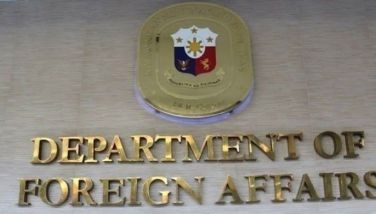Philippines rebranded to boost tourism

MANILA, Philippines — Tell the story of the Philippines to the world by telling the story of love.
This was according to the Department of Tourism (DOT) as it launched the country’s new tourism slogan “Love The Philippines” yesterday, as part of the celebration of the department’s 50th anniversary.
President Marcos, who made the tourism sector among his administration’s priorities, led the launch at the Manila Hotel.
In his speech, Marcos said the new branding would serve as the guidepost for the industry’s swift recovery.
“The campaign that you have conceptualized aims to enhance the overall experience of every traveler. Included in the list of targets are to promote regional products, build more infrastructure for ease of travel and champion green movements, amongst others,” the President told guests and DOT employees, led by Secretary Cristina Garcia Frasco.
“The story of the Filipino has yet to be told. And we shall tell that story by telling them the story of love. Love the Philippines,” Frasco declared in her speech.
The department came up with the “enhanced” tourism slogan “Love the Philippines” as part of its effort to “reintroduce the Philippines to the world.”
“‘Love the Philippines’ goes to the very heart of every single Filipino with the distinct grace and hospitality in which we welcome every guest that comes to our shores, our communities and our homes,” she said.
Recognizing the Philippines’ “natural aspects, long and storied history, rich culture and diversity,” Frasco pointed out “there is so much more to the Philippines than fun and adventure that we have so far articulated to the world.”
The new slogan also comes with derivatives like love the culture, love the heritage, love the sounds, love the feeling, love the experience, love the friendships, love the smiles and love the fun.
The new slogan also aims to “highlight that the Philippines is a destination with a rich and diverse Filipino culture that can offer substantial, immersive and purposeful experiences, perfectly matched with love and warm hospitality of the Filipino people.”
The DOT has used slogans to promote the tourism industry, such as “Wow Philippines” in 2002 and “It’s more fun in the Philippines” in 2012.
On social media, the word “love” was the “positive thing associated with our country, and is frequently mentioned in high volume globally,” according to Marie Adriano, brand and strategic planning head of marketing firm Doyle, Dane and Bernbach Philippines.
She added that while the word “fun” remains a “positive thing” for the country, it has “low volume of mentions.”
“Brand enhancement is an imperative to stay competitive and relevant,” she said.
Also, the preferences of the traveler, especially during the pandemic, have changed, according to Adriano.
“Being stuck (during the COVID-19 pandemic) drove them to seek purpose and to look at travel as the means to find that purpose,” she said.
“The changed traveler of course wants to have fun. But they are looking for more purposeful travel, unique experiences, authentic flavor and self-worth and discovery,” she added.
Frasco earlier announced the department would “enhance” the country’s tourism slogan, to make it in line with the “country brand” conceptualized by the Office of the Presidential Adviser on Creative Communications: “We give the world our best. The Philippines.”
She said the sector generated P1.87 trillion in revenues from foreign visitors in 2022 and provided jobs to 5.35 million Filipinos.
Tourism Development Plan
In his speech, Marcos said programs to boost tourism are laid down in detail in the National Tourism Development Plan for 2023 to 2028 approved last March.
“The five-year plan stemmed from this administration’s determination to implement programs that will positively transform our country towards being a tourism powerhouse in Asia in the coming years,” Marcos said.
The President cited the country’s improving tourism revenues and increasing employment as well as international and domestic arrivals.
“All of these are encouraging signs that the tourism industry in our country as a whole is headed well towards full recovery,” he said.
“It also conveys a strong message to the world that we are ready and fully equipped to welcome tourists, travelers as well as investors,” he added.
Marcos also urged Filipinos be the country’s tourism ambassadors.
“I enjoin you all to be our country’s promoters, advocates and, if I may borrow a coined term in this age of social media, be our country’s top influencers,” the Chief Executive said.
“Indeed the Philippines will never run out of places to discover, of meals to enjoy, adventures to experience, people to meet, talents to admire,” he said.
Marcos reiterated his commitment to vigorously develop the tourism industry, noting that such undertaking goes deeper than merely stimulating economic activities and generating job opportunities.
“It springs from the genuine love, me and all of us have for the Filipinos. And what better way to express that love than directly incorporating it into our country’s newest tourism campaign slogan, Love the Philippines,” he said.
During the event, Marcos received from Frasco a special plaque of appreciation for his late father and namesake “whose contributions to the tourism industry have been very significant, primarily on the creation of the department 50 years ago.”
Marcos Sr. issued Presidential Decree No. 189 on May 11, 1973 to integrate a reorganization plan by renaming the Department of Trade and Tourism as the Department of Tourism.
At yesterday’s event, the DOT also recognized its former secretaries like Richard Gordon, Roberto Pagdanganan, Rafael Alunan III, Gemma Cruz-Araneta and Wanda Teo. Former secretaries Bernadette Romulo-Puyat, currently deputy governor of the Bangko Sentral ng Pilipinas, and Ace Durano were absent during the event.
Big-ticket projects
In a statement, the Department of Transportation (DOTr) said it is open to collaborating with neighboring countries and stakeholders to facilitate the completion of big-ticket projects.
Tourism development has long been hampered by poor infrastructure.
DOTr Secretary Jaime Bautista said collaborations can “hasten infrastructure projects and transport initiatives, aimed at improving travel experience.”
“We did not waste any time rushing projects to reduce traffic, waiting lines, smoke-belching jeepneys, flight cancellations and other travel inconveniences,” Bautista said.
Some of the big-ticket projects are the privatization of the Ninoy Aquino International Airport and the modernization of public utility vehicles.
The department is also looking at replicating the EDSA busway system in Cebu City and Davao City.
The DOTr is also rushing rail projects such as the LRT-1 Cavite Extension, North South Commuter Railway, Metro Manila Subway and the MRT-7, among others.
The DOTr, according to Bautista, “has been relentless in upgrading numerous seaports, making the countryside competitive for trade, investment and tourism, while ensuring coastline safety and upgrading the skills of Filipino seafarers.”
Local airlines, meanwhile, will have to make do with reduced flights and restructured schedules if they wish to keep their services acceptable, amid a global supply chain problem for aircraft parts, Civil Aeronautics Board (CAB) executive director Carmelo Arcilla said on Monday.
“So, we told the airlines early on, we do not have any choice but to reduce the flights and restructure the schedules. So now, [things will] gradually stabilize,” Arcilla said in an interview aired over One News’ “The Chiefs.”
“The purpose of reducing the flights is to fit and align the number of flights with the equipment that is available. The purpose is to stabilize and make the services more reliable,” he added.
“I am sure that you are aware about the circumstances around this event, that we have a disruption in the global supply chain, including the airspace industry. This disruption has affected the global aviation industry,” he said in a mix of English and Filipino.
“There is a lack of equipment to sustain the planned schedules. The effect of this is for the airlines to cancel the flights. [But] a lot of passengers went to the airport and when they arrived, the flights were cancelled,” he added. Arcilla explained.
He said he expects the situation to “stabilize” soon.
“This is something not foreseen by the global industry at large, otherwise other airlines would not have suffered the same way,” he added. — Ralph Edwin Villanueva
- Latest
- Trending































